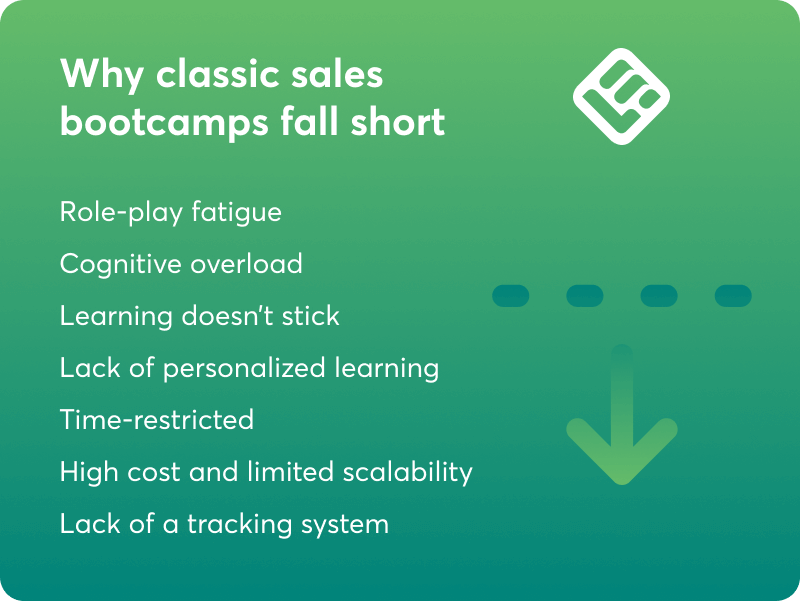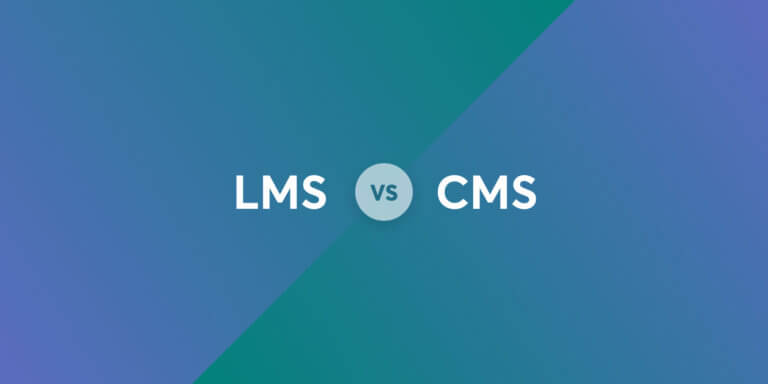Table of Contents
What does it take to sell a good product? Effective marketing, targeted messaging, a strong brand image… and an ace sales team to seal the deal. The more expensive and nuanced your product, the more competent your salespeople must be.
Most salespeople say they’ve been born with a sales DNA. And maybe that’s true. But just like a talented athlete needs diligent practice to win the gold medal, your talented sales reps need training to hone their skills and perform at their best.
Sales training is largely practice-oriented and performed on the job. But with a Learning Management System (LMS), you can take your training up a notch or two.
If you haven’t tried using an LMS for your sales enablement programs yet, we’re here to show you why it’s important. You’ll also discover what features you need to look for specifically for your sales training needs.
Here’s what we will be covering in this blog post:
Why classic sales bootcamps stall
A sales bootcamp is a fast-track onboarding program designed to teach salespeople, often new hires or those transitioning into new roles, the skills, tools, and processes they need to succeed in their roles.
More than 26% of sales representatives claim that their sales training has little to no effect [1]. Although the delivery method or duration are not mentioned, this is an alarming percentage. And one thing is for sure: sales bootcamps do not cut it. Here’s why:

Role-play fatigue
Or rather, a lack of engagement. Most sales bootcamps focus on simulating real-life situations your sakes reps encounter on the job. But how many times can they go over the same sales pitch and play out the same scenarios? While it can be effective and engaging at first, eventually they get bored. And it gets worse.
Cognitive overload
Boredom is the least of your problems. In the sake of rep ramp acceleration, many teams squeeze everything into short bootcamps. Tool demos, selling tactics, policies, product specs, the works. It’s a fire-hose of info that leaves people overwhelmed. Even when they do remember it all, the process feels draining, not empowering.
Learning doesn’t stick
Bootcamps are not only fast, they are also one-time events. This gives participants little time to process the new information. If they do not apply their new skills on the job right away, it’s unlikely that any of the learning that took place so fast will actually stick long term.
Lack of personalized learning
Tailored learning experiences are more successful than generic ones. Unfortunately, sales bootcamps are a perfect example of the imperfect one-size-fits-all approach. Every participant receives the same training materials regardless of their experience level, progress, or preferences.
Time-restricted
Whether online or on-site, bootcamps have a fixed schedule, which can be problematic. This is especially true for employees who already have a clientele and work schedule, and are not newbies anymore.
High cost and limited scalability
Running live bootcamps requires significant time from sales managers and often includes travel and accommodation expenses. This makes it all the more difficult to scale as your company grows and you need to repeat these bootcamps.
Lack of a tracking system
Even when a bootcamp seems to go well, it’s hard to measure how much employees have actually retained, whether they were engaged during the event, and whether they found it useful. On-site role-play scenarios and surveys can only go so far in conveying this information.
All in all, sales bootcamps are a good starting point, but they are not enough to support continuous development. To truly enable your sales team, you need structured sales training that combines interactive experiences with ongoing, trackable training that adapts to each sales rep’s needs. And to offer effective sales training that doesn’t drain them, you need the right tech.
Enter the sales training LMS.
5 awesome capabilities of a sales training LMS
Yes, a sales training LMS is pretty awesome, and we’ll explain why.
Flexible training delivery
A sales training LMS allows you to deliver training in any way you like. You can reinforce on-site bootcamps with training materials and give employees the option to attend remotely. You can also deliver self-paced training, host live training sessions online, or provide lessons via mobile. A mobile LMS and especially a dedicated mobile app is built for field readiness, offering offline access, learning reminders, and seamless user experience on every mobile device
Engagement and knowledge retention features
Facilitate knowledge retention with microlearning, interactive video, quizzes, and a variety of training content for every learning preference and every training need. With a sales enablement platform, you can rest assured your sales rep will take the time they need to go over their training and revisit valuable resources when they need to.
Personalized learning paths
It’s possible to reach a high degree of personalization using various features like user tagging and grouping. In this way, your employees are assigned courses based on selected criteria, course requirements, and content drip-feeding. They can move on to the next lesson once they have successfully completed the previous one.
ROI analytics & CRM sync
Modern learning platforms do more than track learner progress. They demonstrate how sales training is tied to business success and prove training ROI through advanced analytics. Thanks to a CRM integration, you can directly link learning activities to your sales pipeline and track pipeline influence analytics, seeing exactly how training impacts the sales process.
Multi‑tenancy
If you’re enabling multiple sales teams or external partners across several locations, a robust LMS can support multi‑tenant portals and branded academies for different audiences. These features not only enhance brand recognition but also facilitate and streamline administrative tasks.
Choosing the best sales training LMS: 4 top options
Equip sales teams with the skills, knowledge, and the confidence they need to sell your product. These are the top lms providers for sales enablement.
LearnWorlds

Customer reviews:
4.7 out of 5
LearnWorlds is an AI-powered training software that supports your sales enablement efforts, offering data driven insights, interactive content and engagement features, and support for multiple training delivery methods. The best thing about LearnWorlds is that it’s an all-in-one platform. There are no hidden costs and all content authoring and reporting capabilities are built in.
Key features
Pricing
LearnWorlds offer a 30-day free trial and the following plans:
| Starter | $29/mo | ||
| Pro | $99/mo | ||
| Learning Center | $299/mo | ||
| High Volume & Corporate | Custom | ||
Annual discount applies. For more information about feature availability per plan, visit our website.
TalentLMS

CUSTOMER REVIEWS:
4.6 out of 5
TalentLMS is an intuitive platform sales enablement teams in small and medium-sized companies use to train their people. TalentLMS is AI-powered and comes equipped with rich gamification, branded partner portals, and a content library with off-the-shelf content, including sales microlearning modules.
Key features
Pricing
TalentLMS offers a limited free plan that supports up to 5 courses and 10 users. The following prices do not include the Talent Library and come with hard user limits:
| Core (up to 40 users) | $149/mo | ||
| Grow (up to 70 users) | $299/mo | ||
| Pro (up to 100 users) | $579/mo | ||
| Enterprise (above 1000 users) | Custom | ||
Pricing information was retrieved from TalentLMS in July 2025.
Docebo

CUSTOMER REVIEWS:
4.3 out of 5
Docebo is a robust training software that can address the complex needs of sales teams. Powered by AI, multiple integrations with work tools, data drive insights, Docebo is a good option for your next sales training if you run a large enterprise. However, one thing to keep in mind is that Docebo’s baseline functionalities might not meet complex needs. Advanced features like multi-tenancy, deep reporting, advanced course builder, and more, are offered at an additional cost.
Key features
Pricing
Available upon request.
Pricing information was retrieved from Docebo in July 2025.
WorkRamp

CUSTOMER REVIEWS:
4.4 out of 5
WorkRamp offers the Employee Learning Cloud, allowing you to deploy engaging sales training, quick and easy. With a focus on delivering people-centric learning experiences for better engagement and simple yet effective administration, WorkRamp is a good option for mid-sized companies.
Key features
Pricing
Available upon request.
Pricing information was retrieved from WorkRamp in July 2025.
Still unsure about what you need from your LMS? Download our free ebook “The 5 non-negotiables when choosing your LMS” to learn more about features it shouldn’t miss.
Your 8-step playbook for successful sales enablement
We’ve covered the basics, so let’s move to the action part now. Even the best learning platform can’t perform miracles if you go into this without a plan. Let’s build your sales enablement strategy, step by step.
1. Define your objectives and KPIs
What is it that you want to achieve? Do you want to boost sales performance? Which skills do your sales teams need to have to get you there? Do they need to learn a new sales tool? Set specific objectives without going overboard. Keep it realistic.
Take stock of where you are now (eg. support tickets, SCAT scores) and where you want to be. Use the SMART methodology to set attainable goals that will be tied to business KPIs. Success metrics are essential as a reference.
2. Understand your skill gaps
Unless you’re developing onboarding material which is pretty standard, you have to identify where you currently stand. Conduct interviews with sales teams, speak with managers and individual employees if needed. Roll out surveys and conduct skills assessments and product knowledge quizzes.
Skills gaps and business objectives need to come together to shape your strategy.
3. Outline your strategy
Next, think about how you will materialize these goals. What kind of training do you want to offer? Which formats do you want to use? Will you combine sales coaching sessions with on-demand training? A sales training platform gives you many options to shape your sales enablement programs as you need to. If you’re unsure about which is the best way to go, most vendors offer consulting services.
4.Choose your sales training LMS
Once you have your strategy mapped out, it’s easy to find the training software that will make it all come together. Read customer reviews, take advantage of free trials and demos, and talk to sales to find the right sales training LMS for your needs.
Pick the best sales enablement LMS for your team by asking vendors the right questions. Our free RFP template has a prebuilt questionnaire to speed up and improve the selection process.
5. Start building content
You can build content from scratch where needed, buy off-the-shelf content for soft skills training, or repurpose existing content. For example, you can turn product guides into video scripts.
This is why it’s important to choose an AI-powered platform. The ability to repurpose and edit content with AI can significantly reduce development time even if you don’t have a dedicated L&D team.
In our recent webinar “How we built a smarter academy 10x faster,” we discussed how we turned support articles into video scripts for our customer education academy. Watch it now to learn more about the process and the benefits we got from this approach.
6. Roll out your program
As you start building content, start building excitement as well. Let your sales teams know that there’s something in the making. Explain how they will benefit from the sales skills training and what they should expect in terms of time, commitment and learning methods.
7. Track results and collect feedback
Use LMS analytics to measure employee performance and engagement and also the impact of the program on your sales cycles. Completion rates, quiz scores, and average time spent on activity are some useful metrics.
Look at how training impacts sales metrics as well, like time-to-quota for newcomers. Gain direct feedback from reps and managers through surveys and interviews. The more you measure, the more you improve.
8. Reiterate
Continuous improvement is a prerequisite for a successful sales team. The market changes, competition soars, consumer demands keep rising. Apart from collecting feedback and tracking business metrics, you also have to stay in the loop with market changes and the most modern sales techniques, so you keep improving your program and keep boosting your sales team performance.
Moving forward
We’ve explored why bootcamps alone fall short, how an LMS unlocks ongoing learning, and which platforms lead the way. Now it’s your turn. Sign up for a 30-day free trial with LearnWorlds and build engaging training programs with real results.
This is an h3 title without numbering
1. 130+ Sales Statistics to Guide You This Year

Androniki Koumadoraki
Androniki is a Content Writer at LearnWorlds sharing Instructional Design and marketing tips. With solid experience in B2B writing and technical translation, she is passionate about learning and spreading knowledge. She is also an aspiring yogi, a book nerd, and a talented transponster.




